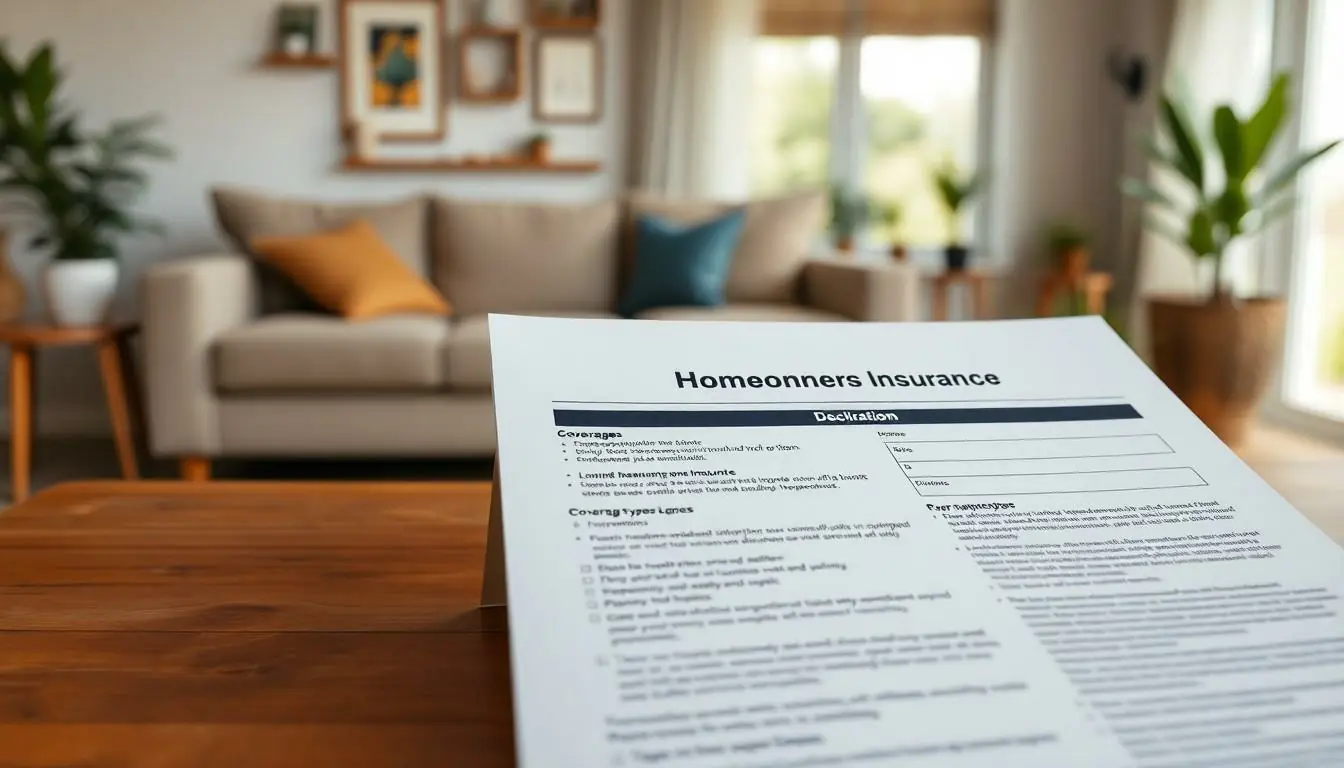Homeowners insurance is like that trusty umbrella you carry on a sunny day—often overlooked until the storm hits. But what’s the first thing you need to know about your policy? Enter the homeowners insurance declaration page, the unsung hero of your insurance documents. This magical piece of paper holds all the essential details about your coverage and can save you from potential headaches down the road.
Think of it as the menu at your favorite restaurant. It lists everything you’re getting, from the coverage limits to the deductibles, and even the fine print that can make or break your claim. Understanding this page not only keeps you informed but also empowers you to make smart decisions about your home and finances. So let’s dive into the world of homeowners insurance declarations and uncover what makes this page a must-read for every homeowner.
Table of Contents
ToggleUnderstanding Homeowners Insurance
Homeowners insurance protects residential properties from damages or losses. This type of insurance typically covers the dwelling, personal property, liability, and additional living expenses. Policyholders should examine their coverage limits to ensure they align with the value of their homes and possessions.
The declaration page serves as a summary of the homeowners insurance policy. It provides essential details such as the insured property’s address, coverage types, and limits. Understanding the specific coverage amounts helps homeowners feel confident in their financial protection.
Deductibles also appear on the declaration page. A deductible represents the amount homeowners must pay out of pocket before the insurance coverage kicks in. Lower deductibles usually mean higher premiums, while higher deductibles often lower premium costs. Homeowners should analyze their financial situations to choose an appropriate deductible.
Liability coverage is another key component found in policies. This coverage protects homeowners from legal claims related to injuries or damages that occur on their property. Many insurance experts recommend liability limits of at least $300,000 to ensure adequate protection.
Personal property coverage encompasses belongings inside the home. Items such as furniture, electronics, and clothing fall under this category. Homeowners should document their possessions and assess their total value to determine if additional coverage is necessary.
Reviewing the homeowners insurance declaration page regularly ensures that the information remains current. Changes in property value, renovations, or significant purchases impact insurance needs. It’s essential to consult with an insurance agent for guidance when making changes to the policy.
What Is a Homeowners Insurance Declaration Page?

A homeowners insurance declaration page serves as a summary of an insurance policy. It’s essential for homeowners to understand this document as it outlines critical coverage details.
Definition and Purpose
The declaration page defines the homeowners insurance policy and outlines primary coverage areas. It conveys information like the insured property’s address and policy number. Homeowners use this page to quickly reference policy types, limitations, and coverage amounts. Understanding its contents ensures they grasp their financial protection against potential losses or damages. This document is vital for identifying the scope of coverage, streamlining the claims process, and providing clarity during unforeseen events.
Key Components of the Declaration Page
Several key components appear on the homeowners insurance declaration page. These include the named insured, property address, and policy period, which confirm who the policy covers and when it is effective. Coverage types, such as dwelling, personal property, and liability limits, reveal the extent of protection available. Deductibles also appear, indicating the out-of-pocket amount homeowners must handle before insurance applies. Lastly, endorsements may detail any policy modifications or additional coverage options, providing flexibility for unique situations. Understanding each component enables homeowners to make informed decisions about their insurance needs.
Importance of the Declaration Page
The declaration page is vital for understanding a homeowners insurance policy. This document offers a clear summary of coverage, limits, and deductibles.
Coverage Overview
Coverage details on the declaration page inform homeowners about protection levels. It specifies dwelling coverage, personal property coverage, and liability protection. Dwelling coverage safeguards the structure of the home, while personal property coverage includes belongings like furniture and electronics. Liability coverage protects against legal claims for injuries occurring on the property. Each category’s limits highlight potential payouts in case of a loss. Homeowners can feel confident knowing these essential distinctions and ensuring adequate protection.
Proof of Insurance
Proof of insurance serves as vital evidence for homeowners and mortgage lenders. The declaration page confirms active coverage and details regarding the insured property. Lenders often request this document to verify that policies remain in effect. Homeowners may also need to provide proof for rental agreements or contractor negotiations. Essential information on the declaration page, like policy numbers and coverage amounts, simplifies these situations. It provides peace of mind knowing they can quickly access this key document when necessary.
How to Read Your Declaration Page
Reading a homeowners insurance declaration page requires attention to specific details. Understanding various sections can simplify the process and enhance financial protection.
Common Terms Explained
Terms on the declaration page include essential components homeowners encounter frequently. Named insured refers to individuals covered under the policy. Insured property indicates the specific address that the policy protects. Coverage types identify what aspects of the home or belongings receive protection. Deductibles specify the amounts homeowners pay out-of-pocket before insurance applies. Endorsements represent any additional coverage or modifications made to the policy. Knowing these terms ensures homeowners grasp the full scope of their insurance.
Identifying Your Coverage Limits
Coverage limits define the maximum amounts insurers pay for claims related to specific aspects. Homeowners should focus on dwelling coverage, which protects the physical structure of their house. Personal property coverage addresses belongings located inside the home. Liability coverage, crucial for protecting against lawsuits, typically recommends limits starting at $300,000. Reviewing these limits provides clarity about protection levels. Homeowners can evaluate whether adjustments are necessary based on their financial circumstances or property value changes. It’s beneficial to consult an insurance agent when assessing adequate coverage levels.
Understanding the homeowners insurance declaration page is vital for every homeowner. It serves as a comprehensive summary of coverage details that can significantly influence financial security. By familiarizing themselves with this document, homeowners can make informed choices about their insurance needs and ensure they’re adequately protected against potential risks.
Regularly reviewing the declaration page is essential to maintain appropriate coverage levels. Homeowners should also consult their insurance agents for tailored advice. This proactive approach not only enhances financial protection but also fosters peace of mind in an unpredictable world.



